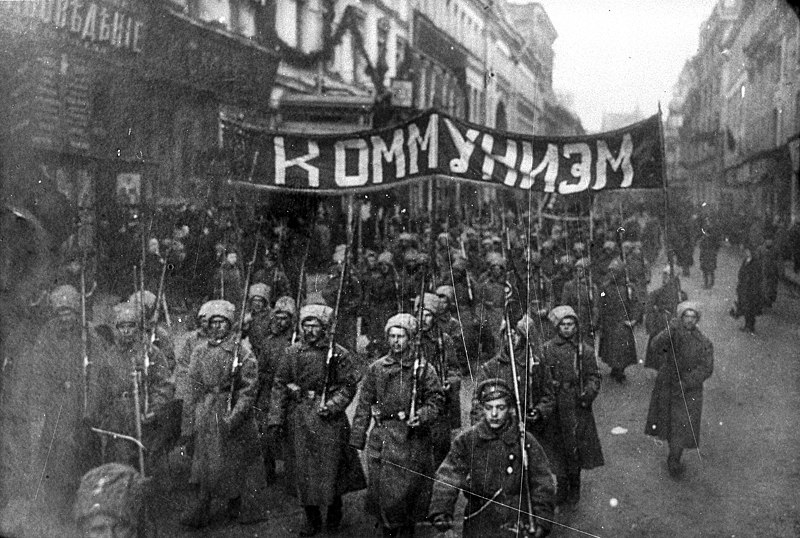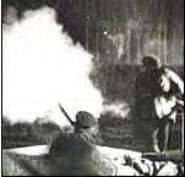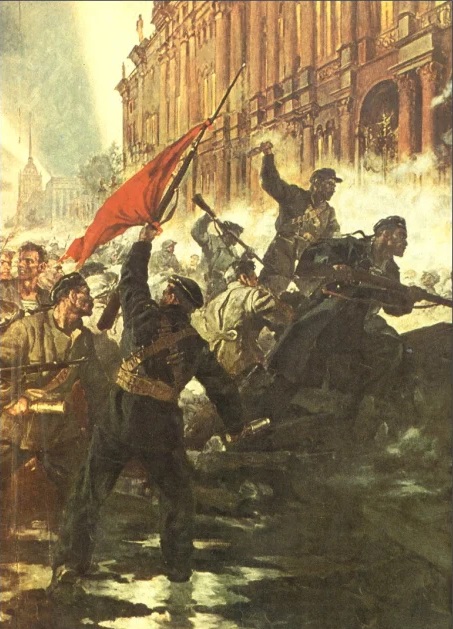|
|
|
|
Summary Until the 1990s, ‘Liberal’ historians used to think that the October Revolution was a was “a classic coup d'etat by a small band with hardly any mass involvement” (Richard Pipes, 1995). Nowadays, ‘revisionist’ historians temd to question the ‘efficiency’ of the coup, and stress instead its mass-support. Note that, because of the Russian Calendar, the ‘October’ Revolution took place in November. All dates on this webpage are NS, but you can click the blue bold dates to see the equivalent OS date .
Source AOn 20 October, urged on by Lenin, the Petrograd soviet took the crucial decision to attempt to seize power. Leon Trotsky, chairman of the soviet, made most of the plans, which went off without a hitch. During the night of 6-7 November, Bolshevik Red Guards occupied all key points and later arrested the provisional government ministers except Kerensky who managed to escape. It was almost a bloodless coup, enabling Lenin to set up a new soviet government with himself in charge. The coup had been successful because Lenin had judged to perfection the moment of maximum hostility towards the Kerensky government, and the Bolsheviks, who knew exactly what they wanted, were well disciplined and organised, whereas all other political groups were in disarray. Norman Lowe, Mastering Modern World History (1982)
Source BThis was not a rising of the masses as the March revolution and the July Days had been. It was a conflict between two small groups…. The Provisional Government had dwindled to a meeting of ministers in the Winter Palace. A few Red Guards climbed in through the servants’ entrance and arrested them... One sailor was killed when his rifle went off in his hand. Four Red Guards and one sailor were killed by stray bullets. That was the total death toll on this historic day. Most people in Petrograd did not even know that a revolution was taking place. AJP Taylor (1977)
|
Going DeeperThe following links will help you widen your knowledge: Reasons for the success of the October Revolution - BBC Bitesize Old Bitesize - on the WaybackMachine October Revolution - notes (pdf) A description of the Fall of the Winter Palace by Louise Bryant, an American journalist
Lenin v Trotsky: who was more important?
Old textbook accounts of the October/November Revolution PJ Larkin, Revolution in Russia (1965) Reed Brett, European History (1967) |
|
Events of the 'October' Revolution Red Guards took over bridges, railways stations, telephone exchange and electricity supply. Lenin goes to the Central Bolshevik Committee and forces them to declare the revolution. Red Guards took over banks and government buildings. The cruiser Aurora shelled the Winter Palace. That night (9.40 pm) the Red Guards took the Winter Palace and arrested the Provisional Government leaders. Lenin announced the new Communist Government.
|
Consider:1. Analyse Sources A-B. What are the key messages about the October Revolution that readers will take away? 2. To what extent does the list of 'Events of the October Revolution' support your impression?
|
Why did the Bolshevik Revolution of November 1917 succeed?[Perhaps Seven Powers Gave Lenin An Opportunity]
If you have analysed Source A, you already have a very simplified idea of what Traditionalists Used To Say (TUTS) about Nicholas II’s Russia. Modern histories, however, have revealed a different picture of things We Only Recently Discovered (WORD), and you can reveal what they are saying by clicking the orange arrows.
1. Provisional Government problemsTUTS: The Bolsheviks succeeded because the Provisional Government was weak and unpopular (remember Government That’s Provisional Will Be Killed). When it was attacked, nobody was prepared to defend it.
|
|
2. Slogans and supportTUTS: The Bolsheviks had good slogans such as ‘Peace, Bread, Land’ and ‘All Power to the Soviets’. Other parties claimed they could never deliver their promises, but their arguments were too complicated for people to understand. This meant that the Bolsheviks got the public’s support.
|
|
3. Pravda and propagandaTUTS: The party ran its own propaganda machine, including the newspaper Pravda (‘Truth’), which got their ideas across
|
|
4. German moneyTUTS: The Germans financed the Bolsheviks because they knew that Lenin wanted to take Russia out of the war. This gave them the money to mount their publicity campaigns.
|
|
5. LeninTUTS: A brilliant leader – a professional revolutionary with an iron will, ruthless, brilliant speaker, a good planner with ONE aim – to overthrow the government. The Bolsheviks were well-led.
|
|
6. Armed forceTUTS: A private Bolshevik army (the Red Guards), dedicated to the revolution, was set up and trained under Leon Trotsky. It gave the Bolsheviks the military power to win.
|
Red Guards marching in Moscow, 2 November 1917. The banner reads: 'Communism'. |
7. OrganisationTUTS: The Bolsheviks were brilliantly organised. A central committee (controlled by Lenin and other leading Bolsheviks) sent orders to the soviets, who gave orders to the factories. Unlike the Provisional Government, the Bolsheviks demanded total obedience from their members, so they were well-disciplined (members did what the leaders wanted).
|
|
Source C[The Second Congress of Soviets meets as the Revolution has begun. The Mensheviks walk out: "Let them go," cries Trotzky, "They will be swept into the garbage-heap of history."]
Behind the Soviets are rolling up solid battalions of support. Every minute brings news of fresh conquests of the Revolution - the arrest of ministers, the seizure of the State Bank, telegraph station, telephone station, the staff headquarters. One by one the centers of power are passing into the hands of the people. The old government is crumbling before the hammer strokes of the insurgents. A commissar, breathless and mud-spattered from riding, climbs the platform to announce: "The garrison of Tsarskoye Selo for the Soviets. It stands guard at the gates of Petrograd." From another: "The Cyclists' Battalion for the Soviets. Not a single man found willing to shed the blood of his brothers." Then Krylenko, staggering up, telegram in hand: "Greetings to the Soviet from the Twelfth Army! The Soldiers' Committee is taking over the command of the Northern Front." And finally at the end of this tumultuous night, the simple declaration: "The Provisional Government is deposed..." Pandemonium! Men weeping in one another's arms. Couriers jumping up and racing away. Telegraph and telephone buzzing and humming. Autos starting off to the battle-front; aeroplanes speeding away across rivers and plains. Wireless flashing across the seas. All messengers of the great news! The will of the revolutionary masses has triumphed. The Soviets are the government. This historic session ends at six o'clock in the morning. The delegates, reeling from the toxin of fatigue, hollow-eyed from sleeplessness, but exultant, stumble down the stone stairs and thru the gates of Smolny. Outside it is still dark and chill, but a red dawn is breaking in the east. Eyewitness account of Arthur Rhys Williams, Through the Russia Revolution (1921)
Source EFew historical events have been more profoundly distorted by myth than those of 25 October 1917. The popular image of the Bolshevik insurrection, as a bloody struggle by the tens of thousands with several thousand fallen heroes, owes more to Oktyabr – Eisenstein’s brilliant but largely fictional propaganda film to commemorate the tenth anniversary of the event – than to historical fact. The Great October Socialist Revolution, as it came to be called in Soviet mythology, was in reality such a small-scale event, being in effect no more than a military coup, that it passed unnoticed by the vast majority of the inhabitants of Petrograd. Theatres, restaurants and tram cars functioned much as normal while the Bolsheviks came to power. The whole insurrection could have been completed in six hours, had it not been for the ludicrous incompetence of the insurgents themselves, which made it take an extra fifteen. The legendary ‘storming’ of the Winter Palace, where Kerensky’s cabinet held its final session, was more like a routine house arrest, since most of the forces defending the palace had already left for home, hungry and dejected, before the assault began… The first part of the plan went smoothly enough: shortly before noon a group of Bolshevik soldiers and sailors burst into the Marinsky Palace and ordered the deputies to disperse. But after that elementary technical failures forced the MRC to postpone the operations around the Winter Palace until 3 p.m., then 6 p.m., whereafter it ceased to bother with any set deadlines at all. The first major hold-up was the late arrival of the Baltic sailors, without whom the MRC would not go ahead. Then there was another, even more frustrating, problem. The assault on the Winter Palace was due to begin with the heavy field-guns of the Peter and Paul Fortress, but at the final moment these were discovered to be rusty museum pieces which could not be fired. - Soldiers were hastily sent out to drag alternative cannons up to the fortress walls, but when these arrived it turned out that there were no suitable shells for them. Even more surreal was the panic created by the seemingly simple task of raising a red lantern to the top of the fortress’s flagpole to signal the start of the assault on the palace. When the moment for action arrived, no red lantern could be found. The Bolshevik Commissar of the Fortress, Blagonravov, went out in search of a suitable lamp but got himself lost in the dark and fell into a muddy bog. When he finally returned, the lamp he had brought could not be fixed to the flagpole and was never seen by those who took part in the assault. In any case, it wasn't red. Orlando Figes, A People’s Tragedy (1996)
Source FMany of the photographs and film people believe they have seen of the Russian revolution are in fact taken from films by the Soviet Director Eisenstein after the event. For instance I've seen Socialist Worker (Ireland) use a still from Eisenstein’s recreation of the storming of the Winter Palace alongside an article on the Russian Revolution. These along with rather glib accounts have created an entirely false view of what the Revolution was. The Bolsheviks did not set a date for revolution until it was in progress (the day before the Winter Palace fell). This was when the revolutionaries found themselves holding the rest of Petrograd after Kerensky’s forces, ordered on the offensive in the city (to gain control of the city bridges) instead melted away. The Winter Palace far from being stormed in a massive military offensive was in fact taken as soldiers, workers and peasants entered through the basement only to be taken prisoner. However, before long the 'prisoners' outnumbered the soldiers loyal to the government who recognising this surrendered to them. In fact the front of the Palace was so quiet that Kerensky, the head of the government was able to escape by driving out in his car. Those revolutionary soldiers who did recognise him reacted not by arresting him (as they would if this was a planned procedure) but by saluting and standing aside for the car to pass. Andrew Flood, writing on an Anarchist website (1997)
|
Source DLater depictions of the October Revolution - such as this still from Sergei Eisenstein's 1927 film Oktyabr:
– were Bolshevik propaganda, and showed the revolution as an heroic workers’ struggle. Later Soviet paintings of the October Revolution, such as this one:
also showed it as a popular uprising similar to the March Revolution.
Consider:3. Analyse Sources C and D What impression of the October Revolution do they give? Why? 4. How do they contrast with Sources E ad F. Why? 5. From what you have learned of the Revolution, who would you say played the more important role, Lenin or Trotsky? 6. Do we need to pay more attention to the role of women in the Revolution?
|
Consider:7. Building on your analysis of Sources A-B, using ONLY the' traditionalist' (TUTS) statements and information, list in order of importance the seven reasons the Bolsheviks succeeded. Explain to acriticafriend why you put them in that order. 8. I did that for my students in the 1990s.
9. Now go through the more up-to-date (WORD) ideas. Do they cause you to re-assess (up or down) the importance of any of the factors? Re-order your list taking ALL the information on this webpage into account. Explain your changes. 10. Debate: what was the 'main reason' the Bolsheviks succeeded?
|
|
|
| |


